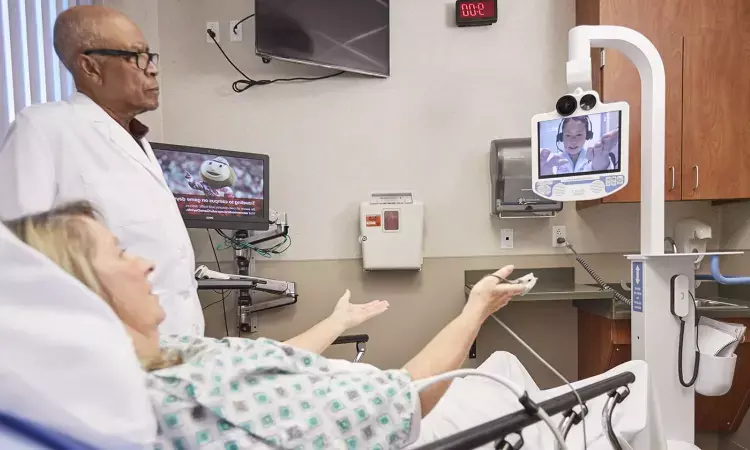- Home
- Medical news & Guidelines
- Anesthesiology
- Cardiology and CTVS
- Critical Care
- Dentistry
- Dermatology
- Diabetes and Endocrinology
- ENT
- Gastroenterology
- Medicine
- Nephrology
- Neurology
- Obstretics-Gynaecology
- Oncology
- Ophthalmology
- Orthopaedics
- Pediatrics-Neonatology
- Psychiatry
- Pulmonology
- Radiology
- Surgery
- Urology
- Laboratory Medicine
- Diet
- Nursing
- Paramedical
- Physiotherapy
- Health news
- Fact Check
- Bone Health Fact Check
- Brain Health Fact Check
- Cancer Related Fact Check
- Child Care Fact Check
- Dental and oral health fact check
- Diabetes and metabolic health fact check
- Diet and Nutrition Fact Check
- Eye and ENT Care Fact Check
- Fitness fact check
- Gut health fact check
- Heart health fact check
- Kidney health fact check
- Medical education fact check
- Men's health fact check
- Respiratory fact check
- Skin and hair care fact check
- Vaccine and Immunization fact check
- Women's health fact check
- AYUSH
- State News
- Andaman and Nicobar Islands
- Andhra Pradesh
- Arunachal Pradesh
- Assam
- Bihar
- Chandigarh
- Chattisgarh
- Dadra and Nagar Haveli
- Daman and Diu
- Delhi
- Goa
- Gujarat
- Haryana
- Himachal Pradesh
- Jammu & Kashmir
- Jharkhand
- Karnataka
- Kerala
- Ladakh
- Lakshadweep
- Madhya Pradesh
- Maharashtra
- Manipur
- Meghalaya
- Mizoram
- Nagaland
- Odisha
- Puducherry
- Punjab
- Rajasthan
- Sikkim
- Tamil Nadu
- Telangana
- Tripura
- Uttar Pradesh
- Uttrakhand
- West Bengal
- Medical Education
- Industry
Post-TAVR stroke better spotted at specialized centers: JACC

USA: In the hospitals designated as comprehensive stroke centers (CSCs), post-TAVI stroke rates are higher than those without the designation, underscoring concerns about using the complication as a quality metric for TAVR, according to Michigan TVT data.
The researchers, in their study, published in JACC: Cardiovascular Interventions, however, found no differences between center types for other important clinical outcomes, indicating that higher stroke rates in CSCs were not because they were delivering lower-quality TAVI care but because they're better at recognizing the events.
The 30-day stroke rate following TAVR (transcatheter aortic valve replacement) has been indicated as a hospital quality metric. Thirty-day stroke rates for nonsurgical, high, and moderate-risk TAVR trials varied from 3.4% to 6.1%. In contrast, those in the national TVT (Transcatheter Valve Therapy) Registry for the same patient population was much lower. Hospital CSC (comprehensive stroke center) is the highest designation for integrated acute stroke management, recognition, and care.
P. Michael Grossman from the University of Michigan in Ann Arbor, Michigan, USA, and colleagues examined whether there was a variation in in-hospital post-TAVR stroke rates between CSC and non-CSC institutions using Michigan TVT data.
The study included TVT data submitted from the 22 Michigan Transcatheter Aortic Valve Replacement Collaborative participating institutions from 2016 to 2019 comprising 6,231 patients. The relation between hospital CSC accreditation and in-hospital post-TAVR stroke was assessed by accounting for hospital clustering and patient clinical characteristics.
The Institutional Review Board of the University of Michigan has waived the requirement to approve studies based on data collection by the Blue Cross Blue Shield of Michigan Cardiovascular Consortium registry.
The researchers reported the following findings:
- 62.3% of patients were at 9 CSC sites, and 37.7% were at 13 non-CSC locations.
- Significantly higher rates of in-hospital post-TAVR stroke were seen at CSC sites (CSC: 2.65% vs non-CSC: 1.15%).
- After adjustment, patients who underwent TAVR at a CSC hospital had a remarkably higher risk of in-hospital stroke (adjusted OR: 2.21).
- CSC designation was not significantly linked with other important post-TAVR clinical outcomes, including 30-day mortality.
"Our findings showed that TVT stroke rates were significantly higher at sites with the designation status of Joint Hospital Commission stroke; however, there was no significant difference in other reported important clinical outcomes based on this designation," the researchers wrote.
"A possible factor in stroke rate detection differences between TAVR institutions could be CSC designation and might be a factor in the observed differences in stroke rates between TAVR trials and those reported in TVT," the researchers explained. "These findings suggest that comparing hospitals based on post-TAVR stroke rates is potentially problematic."
Reference:
Grossman PM, Sukul D, Lall SC, Villablanca PA, Shannon F, Seth M, Chetcuti SJ, Patel HJ, Deeb GM. The Relationship Between Hospital Stroke Center Designation and TVT Reported Stroke: The Michigan TAVR Experience. JACC Cardiovasc Interv. 2023 Jan 23;16(2):168-176. doi: 10.1016/j.jcin.2022.10.020. PMID: 36697152.
Dr Kamal Kant Kohli-MBBS, DTCD- a chest specialist with more than 30 years of practice and a flair for writing clinical articles, Dr Kamal Kant Kohli joined Medical Dialogues as a Chief Editor of Medical News. Besides writing articles, as an editor, he proofreads and verifies all the medical content published on Medical Dialogues including those coming from journals, studies,medical conferences,guidelines etc. Email: drkohli@medicaldialogues.in. Contact no. 011-43720751


